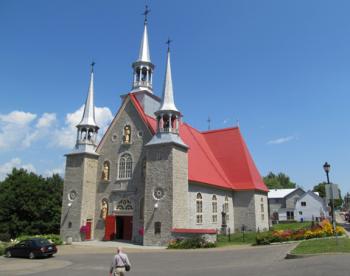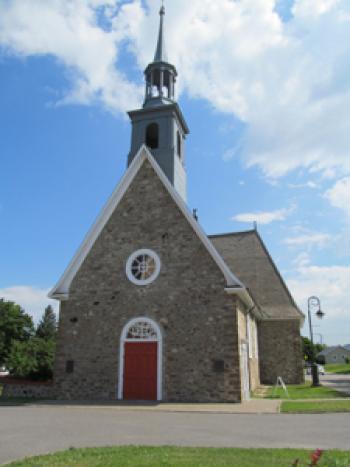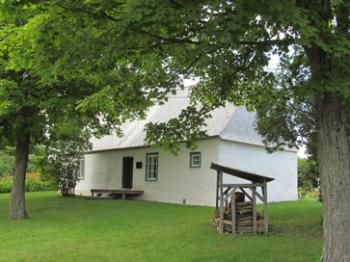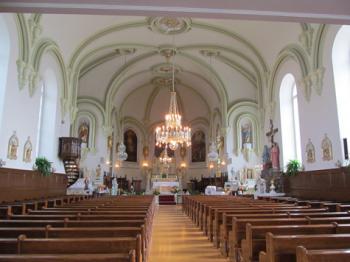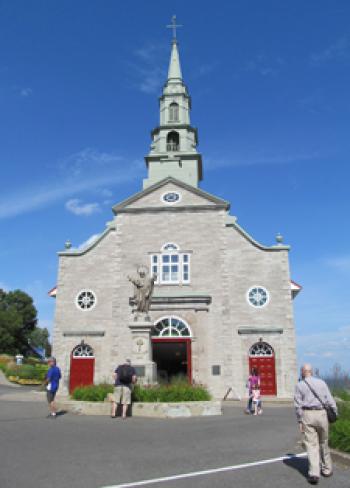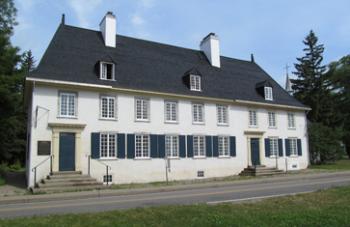Île d’Orléans — French settlement in the New World
This item appears on page 56 of the July 2017 issue.
Seventy-three years before Samuel de Champlain founded the city of Québec in eastern Canada, another Frenchman, Jacques Cartier, sailed up the St. Lawrence River in 1535.
Along his river route lay a large island in the middle of the river. Seeing the abundance of vines and wild grapes on the island, he named it Île de Bacchus (Island of Bacchus) for the Roman god of wine. Soon after, the name was changed to Île d’Orléans in honor of the Duke of Orléans, son of the (then) French king, François I.
A century after Cartier’s voyage, the first settlers arrived on the island in 1636 and with them the clergy, who founded the island’s first parish in 1666 and subsequently built the stone churches in the six villages that soon circled the island.
The Île d’Orléans was one of the earliest European settlements in the New World.
Royal Road encircling the island
Located only 9 miles from Québec City, the Île d’Orléans is about 20 miles long and 5 miles wide. The Chemin Royal (Royal Road) circles the entire island, passing through each of the six villages. It also passes thriving vineyards that prove how accurate was Cartier’s initial name for the island.
It is this road — a circuit of 42 miles — that my husband, Paul, and I wanted to follow, visiting as many of the island’s historical sites as we could during our 2-day excursion from Québec City in August 2016.
We began in the village of Saint-Pierre, the closest village to the bridge that links the Île d’Orléans to the mainland. It’s easy to find the Église Saint-Pierre, since it’s situated beside the Chemin Royal, as are most of the island’s historic churches.
Actually, there are two churches there, sitting companionably beside each other: the old church, built between 1717 and 1719, and the new church, completed in 1955. It is the old church, now no longer used for religious functions, that we wanted to see.
The oldest church on the island, Saint-Pierre has an elegant interior designed in the 1830s by the prominent Québec architect Thomas Baillairgé, a name we were to hear frequently both on the island and in Québec City.
The sheet-metal pipe in the middle of the nave and the box-like pews with doors once helped to keep worshipers warm in the long Canadian winters. The island’s favorite son, the singer and songwriter Félix Leclerc (1914-1988), is buried in the churchyard.
North of Saint-Pierre along the Chemin Royal is Sainte-Famille, with a church built between 1743 and 1747. It is unique for its three bell towers. The interior of this church was also designed by Thomas Baillairgé in the same splendid style as Saint-Pierre.
Ancient stone cottage
The Maison Drouin is one of hundreds of old houses dotting the island. This house is one of the oldest, dating from 1730, and can be visited during the summer season. Basically a Norman-style farmhouse adapted for use in Canada, Maison Drouin was built sturdily and simply, with thick walls, low ceilings and multiple fireplaces to withstand the harsh winters.
Still farther north, at the northern tip of the Île d’Orléans, is the village of Saint-François, with a church originally built in 1736. In 1988 a disastrous fire destroyed the interior, which had been designed by Thomas Baillairgé. The interior was rebuilt in a modern, scaled-down style. The church’s exterior is the original.
Island garden
The Seigneurie de l’Île d’Orléans is a series of six gardens covering 25 acres of what was once a large, 17th-century land grant called a seigneurie. We missed the aromatic lavender season when the fields bloom with lavender plants (approximately the first three weeks in July), but we did enjoy visiting the other gardens, especially the Garden of the Five Senses.
Rounding the tip of the island, we headed south to Saint-Jean. Built in 1734, this church also has an interior designed by Thomas Baillairgé and a graveyard where many island sailors and river pilots lie buried.
The nearby 1734 Manoir Mauvide-Genest, a large manor house built by a prosperous merchant, was, unfortunately, closed due to lack of funds, a situation everyone hoped would be remedied by the 2017 summer season.
History and fine dining
Farther south in Saint-Laurent is Moulin Saint-Laurent, a mill dating from at least 1730. It’s now a restaurant where you can dine inside within 300-year-old walls or outside on a patio beside a tiny waterfall. This gives visitors the opportunity to drink wine made from grapes grown only a few miles away and dine on produce from nearby farms.
The Église Saint-Laurent is a relative newcomer as far as Île d’Orléans churches go. It dates from 1860, replacing several earlier churches. The interior was designed in the early 1860s by Charles Baillairgé, another member of the talented Baillairgé family.
Our last village was Sainte-Pétronille. The highlight there is all around you — the homes in English Regency and Victorian styles built in the 1800s by wealthy Québécois merchants as summer homes.
The 1871 village church named in honor of Pétronille, a first-century-AD Roman martyr, displays on the high altar a statue of the saint holding a broom.
We allowed two days to tour the Île d’Orléans. This was a mistake. We should have allotted three or four, giving us more time to savor the unique charm and history of this laid-back island so close to Québec City.
There are all those vineyards we drove past without stopping to sample their wares (with the sole exception of Cassis Monna & Filles in Saint-Pierre, where we tasted some of the most luscious crème de cassis made from black currants).
If you go…
We hired a car and driver from D2S Limousine (Quebec City; 418/652-7316, www.d2slimousine.com [in French only]). It’s a pricey way to see the island, but it allowed Paul freedom from driving and me freedom from navigating.
We had the good fortune to have as our driver Jean Gosselin, whose family comes from the island. Car and driver for two touring days of about eight hours each came to CAD960 (near $711), not including taxes and tip.
We overnighted in Saint-Pierre at the lovely Les Ancêtres Auberge (1101, Chemin Royal, Saint-Pierre, Île d’Orléans, Québec, G0A 4E0, Canada; 418/828-2718, www.les
ancetres.ca/en), an inn with several centuries of history and only eight rooms. Ours, room No. 1, came with a view of the St. Lawrence and the bridge and cost CAD155 ($115). This was the in-season rate; the off-season rate is lower.
The inn also has a superb restaurant. Dinner with wine cost us CAD110.
Visitors can purchase a passeport that can be used for free or reduced admission to many of the island’s attractions. It costs CAD25 and can be bought on the Île d’Orléans at the Tourism Center, located in Saint-Pierre very close to the bridge. A passeport can also be purchased by credit card in advance by calling 418/828-9411 or, toll free, 866/941-9411.
Those wanting additional information about the Île d’Orléans and its attractions can check www.iled
orleans.com.

